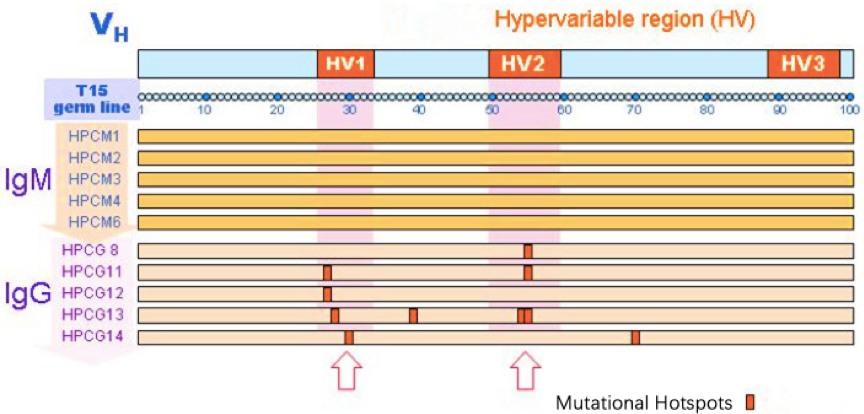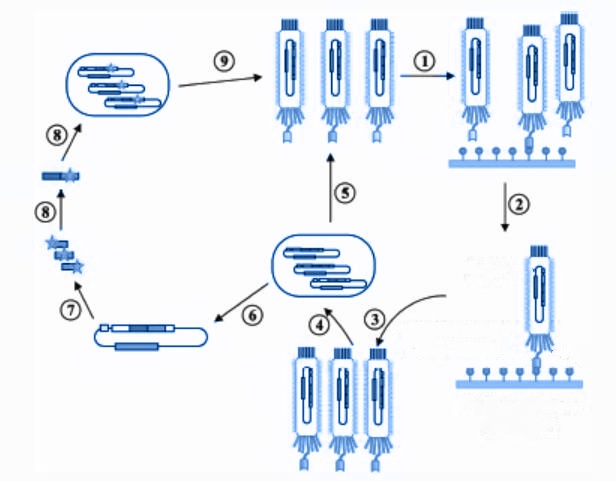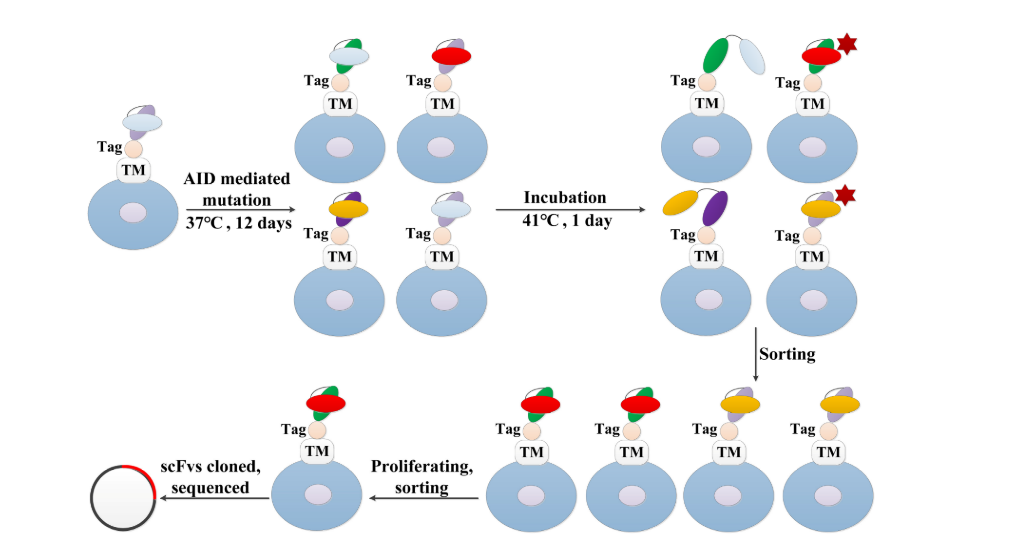2018-11-07 Hits(41)
Documents Antibody Affinity Maturation Inquiry Form() Antibody Phage Display Library Flyer() Phage Display Service()
To achieve a certain therapeutic effect in vivo, the antibody affinity needs to reach a certain level. In addition, the antibody affinity decreased obviously after humanization. Therefore, it is necessary to increase the antibody affinity of humanized antibodies to the pre-humanized level. Affinity maturation is a common strategy to improve the antigen-antibody binding affinity. KMD Bioscience has established a mature antibody production platform with advanced antibody engineering technology. KMD Bioscience offers antibody affinity maturation service that can improve the affinity of antibodies to the desired level.
Supported by our well-established antibody phage display library, KMD Bioscience can provide multi species antibody affinity maturation service. Together with our experienced scientists in antibody affinity maturation, KMD Bioscience can make the affinity of monoclonal antibodies reach 10^-9 M. Better quality antibodies to make your research easier.
Antibody affinity maturation and affinity drug screening are interrelated concepts crucial for developing therapeutic antibodies. Affinity maturation optimizes antibody efficacy, while affinity drug screening identifies antibodies with desired affinity characteristics for drug development. Screening diverse antibody variants using high-throughput techniques like phage display or yeast surface display efficiently identifies lead candidates with superior binding affinity. By combining affinity maturation and drug screening, KMD Bioscience scientists iteratively improve antibody affinity through somatic hypermutation and screening assays. This approach generates optimized antibodies with enhanced affinity for targeted therapeutics. Antibody affinity maturation improves binding affinity, and affinity drug screening selects antibodies with desirable affinities, contributing to the development of high-affinity therapeutic antibodies.
Antibody Affinity Maturation
Affinity maturation is the process by which TFH cell-activated B cells produce antibodies with increased affinity for antigens during an immune response. It is a crucial step in the immune response to ensure the generation of antibodies that effectively bind and neutralize the target antigen. Successive generations of B cells mutate and present to the antigen, that recognizes the antigen with high affinity will survive, and the low-affinity ones are eliminated. KMD Bioscience uses phage display library technology, and combined with error-prone PCR and site-directed mutagenesis, we were able to mimic these over-frequency cellular mutations. Our technical advantage lies in the ability to mutate rapidly in vitro and construct more than 10^10 independent clones of antibody phage display libraries, so that high specificity and affinity antibodies can be obtained in a short time.
Antibody affinity maturation involves somatic hypermutation (SHM) of B-cell immunoglobulin genes, resulting in multiple antibody variants that are selected based on antigen binding for increased affinity. This process occurs in germinal centers within secondary lymphoid tissues, where B-cells undergo rounds of proliferation, mutation, and selection. Selection for antigen binding leads to the preferential expansion and differentiation of B-cells with higher-affinity antibodies. In vitro techniques, such as directed evolution or rational design, can guide affinity maturation to generate antibodies with desired properties.

Antibody Affinity Maturation Service Process

Common Affinity Maturation Technology
Different methods of mutagenesis offer diverse strategies to optimize antibody affinity. Random mutagenesis provides a broad range of mutations, while targeted mutagenesis focuses on specific regions such as CDRs. Chain shuffling generate libraries of diverse variants, enabling the selection of higher-affinity binders.
Targeted mutagenesis, involves introducing specific mutations into predetermined regions of a DNA sequence. In the context of immunoglobulin genes, targeted mutagenesis often focuses on the complementarity-determining regions (CDRs). These regions are responsible for the binding of antibodies to their target antigens. By introducing mutations in the CDRs, researchers can fine-tune the binding specificity and affinity of antibodies to enhance their therapeutic or diagnostic potential.
Random mutagenesis is a technique used to introduce a wide range of unbiased mutations into a DNA sequence. This can be achieved through methods such as error-prone polymerase chain reaction (PCR) or DNA shuffling. Error-prone PCR utilizes DNA polymerases with reduced fidelity, leading to an increased rate of errors during DNA replication. This results in the introduction of random mutations throughout the DNA sequence. This method allows the construction of large libraries containing 10^8 starting from 3 to 10 selected antibodies.
Chain shuffling is a technique used to diversify the sequence of an antibody. It involves the creation of a library of mutant antibody genes, which are then displayed on filamentous phage particles. The phage display system allows for the selection of higher-affinity binders by exposing the phage library to the target antigen. Through an iterative process of binding and enrichment, antibodies with improved affinity can be isolated and further characterized.
Deliverable
--Affinity optimized antibodies sequences.
--Purified antibody with high affinity.
--Comprehensive report and data: including SDS-PAGE and affinity analysis, etc.
Antibody Affinity Maturation Service Highlights

FAQ-Antibody Affinity Maturation
1. What is antibody affinity?
A: Monoclonal antibodies have become the first choice of most drugs because of their ability to target the site of action. Now, more and more monoclonal antibody drugs have been patented in clinical practice to alleviate diseases. However, for the successful development of a therapeutic mAb, the humanization of the monoclonal antibody sequence and the affinity maturation of the antibody are required.Scientists have been trying to solve the problem of antibody affinity in various ways, but due to the high variability of the sequence on the antibody surface, how to improve the binding ability of antibodies and antigens through technology has become a major problem in modern biology.In the clinical practice of some new drugs, researchers generally believe that they can enhance the affinity of antibodies to make the body have a stronger bioactive response, so that doctors can reduce the required dose of the drugs and reduce the potential side effects, which can help control the cost of drugs.In the whole process of immune response, the affinity enhancement of antibodies is a tedious process, which continuously improves the overall efficacy and specificity of antibodies through the action of multiple rounds of somatic hypermutation and clonal selection mechanism, and provides better drugs for disease treatment.Industrial therapeutic antibodies avoid the need for further in vitro affinity maturation, thereby shortening the timeline of antibody development in KMD Bioscience.
2. How do we deal with problems such as low antibody mutation efficiency and difficult screening in the antibody affinity maturation service?
A: When we introduced mutations during the maturation of antibody affinity, the introduced mutations did not give a significant increase in our antibody affinity. The willingness to cause this phenomenon may be that the method of mutation we used is inappropriate, the selection of the mutated region is not appropriate, or the frequency of the mutant is too low during the antibody affinity mutation process. Although selecting the antibodies with the highest affinity from a large number of mutant antibodies is a difficult challenge, we may be disturbed by multiple factors throughout the screening process, such as whether the method used in our screening is sensitive and specific, and whether the environment in which we conducted our experiments is stable. Given the above problems, KMD Bioscience has optimized the mutation strategy, and we use the multiple mutation method to combine the antibody mutation. We can also use structural sites recognized by antibodies and antigens to target sites with a large number of mutated regions. Also, use some high-quality products such as polymerases for high-frequency mutations. During the screening process, KMD Bioscience uses high-throughput screening techniques, such as flow cytometry and surface display technology, which not only improves the screening efficiency but also improves the screening speed and accuracy of high-affinity antibodies. By establishing a standard screening system and experimental process, KMD Bioscience can reduce the possible errors in the experiment, conduct in vitro affinity screening, ensure the affinity maturity of recombinant antibodies, and facilitate the antibody and drug discovery of customers.

Fig: Procedures for the antibody variants. (Reference documentation: Luo R, Qu B, An L, Zhao Y, Cao Y, Ren P, Hang H. Simultaneous Maturation of Single Chain Antibody Stability and Affinity by CHO Cell Display. Bioengineering (Basel). 2022 Aug 2;9(8):360.)
3. When we encounter problems such as low antibody stability and poor experimental reproducibility in the antibody affinity maturity service, how do we deal with them?
A: When we find that the antibody stability is not high during the antibody affinity maturation process, it may be because we need to sacrifice the original stability or specificity of the antibody while improving the antibody affinity. It is also possible that the change in the antibody structure caused by some mutations eventually leads to the weak stability of the antibody, thus affecting the overall performance of the antibody. In antibody affinity experiments, if the reproducibility of the experiment is found to be poor, the results of the experiment also vary greatly between different batches or different laboratories. This may be because of the small changes in the experiment. When making a mutation, we considered the affinity and stability of the antibody, which can prevent excessive optimization from reducing the antibody's performance. KMD Bioscience can combine sophisticated computer simulation and experimental validation to predict what effect the mutation will have on antibody performance. At the same time, we verified and determined the antibodies selected through multiple experiments to ensure the stability and high affinity of the antibodies in the subsequent applications of customers. To ensure the reproducibility of the experiment, we ensure the standardization and consistency of each experimental step by strictly controlling the experimental conditions. At the same time, we also use high-quality reagents and consumables to reduce experimental errors in all aspects. We establish a perfect experimental record and file management system, which can ensure the authenticity and verifiable nature of our experimental data.
4. What are the mutational strategies for antibody affinity maturation technology in vitro?
A: The mutation strategies of in vitro affinity technology are divided into three categories: induced random mutation, strand displacement, and directed mutation. Mis-prone PCR in induced random mutations is a frequently used antibody mutagenesis technique. The efficiency of the target gene is increased by applying a polymerase with a high mismatch rate or adjusting the reaction conditions. Subsequently, multiple rounds of PCR performed repeated random mutagenesis to accumulate mutation frequencies. Strand displacement can retain the heavy or light chains of some specific antibodies needed, and then the two chains are combined to build various displacement libraries. After phage antibody library screening, high-affinity new antibodies can be obtained. In the pharmaceutical industry, directed mutation is the strategy used to enhance antibody drug discovery. There are two main methods of targeted mutation: targeted mutagenesis and random mutagenesis. In targeted mutagenesis, a set of selected residues within the CDR loop will be mutated. In random mutagenesis, the sequence of the variable fragment (Fv) will be randomly mutated. The main drawback of this approach is that the size and capacity of the mutant library is limited. All possible combinations producing mutant forms of CDR are not feasible. Therefore, it is very difficult to consider mutagenesis by some peripheral residues. Selection and computational simulation methods are recognized as useful tools for antibody engineering that aid in antibody drug discovery.
5. What is the principle of antibody affinity maturity?
A: Antibody affinity maturation is a very complex physiological process that requires the cooperation of multiple aspects. When the body encounters a pathogen invasion, the B lymphocytes of our immune system immediately begin to work, and after a series of signals, our antibody affinity matures. During B cell maturation, B cells undergo high-frequency mutations in somatic cells to generate a rich antibody clonal population, while B cells are also activated by external antigens through processes mediated by follicular dendritic cells. Together, these mechanisms of action lead to a significant increase in the average antigen affinity of the B cell offspring and the antibodies they produce, thus achieving the natural optimization of the desired antibody affinity in vivo.In the body's humoral immune system, B lymphocytes produce antibodies in response to antigenic stimulation and induction. In the process of repeated exposure to antigen, high-affinity antibodies are produced, which involves two interrelated processes: first, the germline gene segment of the bone marrow antibody is V- (D) -J random rearrangement to produce a combination of over 10 ^ 6, which is the molecular basis of antibody specific immune response; second, after the body receives antigen stimulation, the antibody gene, especially the complementary determination zone (complementarity determining region, CDR), which causes the change of antibody binding characteristics.
How to Order?

If you have any questions regarding our services or products, please feel free to contact us by E-mail: [email protected] or Tel: +86-400-621-6806;